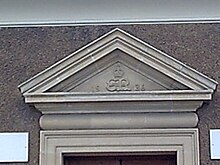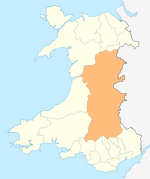Human settlement in Wales
Builth Wells
| |
|---|---|
 Bridge over the River Wye at Builth Wells Bridge over the River Wye at Builth Wells | |
 | |
| Population | 2,568 (2011) |
| OS grid reference | SO035505 |
| Community |
|
| Principal area | |
| Preserved county | |
| Country | Wales |
| Sovereign state | United Kingdom |
| Post town | BUILTH WELLS |
| Postcode district | LD2 |
| Dialling code | 01982 |
| Police | Dyfed-Powys |
| Fire | Mid and West Wales |
| Ambulance | Welsh |
| UK Parliament | |
| Senedd Cymru – Welsh Parliament | |
| Website | builthwellstowncouncil.org.uk |
| 52°08′56″N 3°24′18″W / 52.149°N 3.405°W / 52.149; -3.405 | |
Builth Wells (/ˈbɪlθ ˈwɛlz/; Welsh: Llanfair-ym-Muallt ) is a market town and community in the county of Powys and historic county of Brecknockshire (Breconshire), mid Wales, lying at the confluence of rivers Wye and Irfon, in the Welsh (or upper) part of the Wye Valley. In 2011 it had a population of 2,568.
Etymology
Builth is a longstanding anglicisation of the Old Welsh Buellt or Buallt, which combines bu ([bɨː]) 'ox' and gellt (later gwellt) 'lea or leas'.
The town added Wells in the 19th century when its springs were promoted as a visitor attraction. Its modern Welsh name Llanfair-ym-Muallt means 'Saint Mary in Ox Leas'.
In the centre of the town is a large mural (about 35 feet (11 m) by 30 feet (9.1 m) wide) depicting Llywelyn ap Gruffudd, who was killed at the Battle of Orewin Bridge on 11 December 1282.
Governance

There are two tiers of local government covering Builth Wells, at community (town) and county level: Builth Wells Town Council and Powys County Council. The town council is based at Strand Hall on Strand Street, which also serves as a community hall and events venue.
For elections to Powys County Council the community boundaries are coterminous with the Builth electoral ward, which sends one county councillor to sit on the council. Since 1995 the ward had been represented by Independent councillors. At the May 2017 elections the seat was won by former international rugby player, Jeremy Pugh.
Builth Wells is in the Brecon, Radnor and Cwm Tawe constituency for elections to the UK parliament and Brecon and Radnorshire for elections to the Senedd.
Administrative history
The ancient parish covering the town was called Builth, which formed part of the Builth hundred of Brecknockshire. In 1866 a local government district was created covering the more built-up part of the parish, governed by an elected local board.
Such local government districts were converted into urban districts under the Local Government Act 1894. The urban district was extended at the same time to cover the whole parish of Builth. In 1898, Breconshire County Council changed the urban district's name from Builth to Builth Wells, at the urban district council's request.
Builth Wells Urban District was abolished in 1974, with its area instead becoming a community called Builth Wells within the Borough of Brecknock in the new county of Powys. The former urban district council's functions therefore passed to Brecknock Borough Council, which was in turn abolished in 1996 and its functions passed to Powys County Council.
Livestock breeds

The White Bull of Builth may be a reference to a herd of White Park Cattle that lived in the area from Post-Roman times. Two herds survived in Wales to modern times. The laws of the time suggest that the medieval and later economy of the Welsh borders was strongly dependent on cattle. The Hereford cattle breed, named after Hereford market where it was most prominently sold was the main breed of the Welsh borders. Builth was the market for a variant of the Hereford called the Builth Smokey Face. This was the traditional animal of the area but the breed has not existed for many, many decades.
The Beulah Speckled Face is a local breed of sheep. Nearby Mynydd Epynt was famous for its horses until it was seized for military training purposes.
The beef cattle market has vanished and economically sheep are now vastly more important than cattle with consequences for the traditional woodlands of the area, the salmon runs and other important ecological features.
Industry
Llanelwedd Quarry was the source of the stone used in many of Builth's buildings, and in the dams along the Elan Valley. The quarry was the source of the first laumontite mined in Wales. It is operated by Hanson Aggregates.
Transport

The town is served by Builth Road railway station on the Heart of Wales Line, which is located just over 2 miles to the north-west. The more central (Builth Wells) railway station on the Mid-Wales Railway was opened in 1864, and closed with the line in 1962 – actually before the Beeching Axe. It was located across the river, next to the present showground.
A dedicated cycle route linking the town with Swansea (NCR 43) has been proposed and a 13-mile section of the route from Swansea has already been developed.
One of the main Wales north-south trunk roads, the A483, passes through the town, using the former railway route. As of June 2009 part of this road, along with the other main route through town (A470), is the subject of a transport study by the Welsh Assembly to help alleviate traffic congestion in the town centre.
The bridge at Builth Wells carries vehicles on the A470. It dates from the 18th-century and has six masonry spans, with small cutwaters on the upstream side. The centre of the bridge has two pedestrian refuges. It was built in 1775 and widened in 1925. The river here marks the boundary between the old counties of Breconshire and Radnorshire.
Education and recreation
Ysgol Calon Cymru is the main secondary school and is bilingual. It replaced Builth Wells High School in September 2018 and can draw on certain specialist teachers and facilities as is dual campus with its other site in Llandrindod Wells. In 2000 its predecessor was placed 67th in Wales (by percentage of its children, 59%, gaining 5 GCSEs at full pass grades A*–C). According to a 2010 report by Estyn its rate rose to 77%, making it 9th best performing (state secondary) in Wales and the only ranking in Powys after Llanidloes High School. A fall to two years of Special Measures was followed in 2017 by the closing report of the old school finding sufficient progress to remove it from those measures. Progress was ranked as strong as to six recommendations of 2015, in 2017, and sufficient progress as to the other.
The town features Wyeside Arts Centre, which has two cinemas and a live performance stage.
Builth Wells has a rugby union team called Builth Wells RFC, also known as 'The Bulls', who play on the Groe. The team play in the WRU SWALEC National League 2.
The town's football team is Builth Wells F.C. who play in the Ardal Leagues, the third tier of Welsh football.
Builth Male Voice Choir has approximately fifty members and performs concerts to support local and national charities.
Builth Wells also has a cricket pitch, tennis courts, a sports centre with squash courts, a 25m swimming pool and a bowling green.
Notable people
- Caesar Jenkyns (1866–1941), footballer with over 200 club caps and 8 for Wales
- Percy Benzie Abery (1876–1948), photographer, settled locally in 1898
- Grenville Morris (1877–1959), footballer with over 450 club caps and 21 for Wales, all-time record goalscorer for Nottingham Forest (217 goals)
- David Milwyn Duggan (1879–1942), Canadian politician, emigrated in 1905
- Hilda Vaughan (1892–1985), novelist and short story writer
- Kevin Sheedy (born 1959), a football coach and footballer with 391 club caps and 46 for Republic of Ireland.
- Iolo Williams (born 1962), ornithologist, nature observer, TV presenter and author
- Alice Hart-Davis (born 1963), journalist and author
- Jack Harris (born 1986), singer and songwriter
Buildings and landmarks


Builth Wells has a large number of Grade II listed buildings and fixtures.
A plaque on the wall of the post office stakes its claim as the only in England and Wales to bear a contemporary inscription to less-than-one-year monarch Edward VIII. The claim can be qualified to active post offices as the former one in Bradford-on-Avon has a similar insignia.
After a small health centre opened in the town, Builth Wells Hospital closed in 2013.
References
- "Town and ward population 2011". Archived from the original on 29 July 2014. Retrieved 10 November 2015.
- "What's in a name: Builth Wells". BBC Wales. 2013. Retrieved 12 February 2013.
- Mills, A. D. (2003). "Builth Wells". Oxford Dictionary of British Place Names. Oxford University Press. ISBN 0191578479. Retrieved 14 February 2013.
- "Unveiling of ancient prince mural". BBC News Online. 16 July 2003. Retrieved 13 October 2019.
- "Contact Builth Wells Town Council". Builth Wells Town Council. Retrieved 16 November 2024.
- "Strand Hall, Builth Wells". History Points. Retrieved 16 November 2024.
- "Powys County Council Election Results 1995-2012" (PDF). The Elections Centre. Retrieved 7 September 2018.
- Twm Owen (5 May 2017). "Powys council election – the counting continues". Brecon & Radnor Express. Retrieved 5 October 2018.
- "Builth Ancient Parish / Civil Parish". A Vision of Britain through Time. GB Historical GIS / University of Portsmouth. Retrieved 16 November 2024.
- "No. 23057". The London Gazette. 5 January 1866. p. 87.
- Annual Report of the Local Government Board. 1895. p. 235. Retrieved 16 November 2024.
- "Local Government Act, 1894: Administrative County of Brecon". Radnor Express. Llandrindod Wells. 10 November 1898. p. 4. Retrieved 16 November 2024.
- "Local Government Act 1972", legislation.gov.uk, The National Archives, 1972 c. 70, retrieved 6 October 2022
- "Local Government (Wales) Act 1994", legislation.gov.uk, The National Archives, 1994 c. 19, retrieved 9 October 2022
- "Welsh Black bull takes a firm stand". Wales Online. 13 December 2005.
- "Llanelwedd Quarry, Builth Wells, Powys (Radnorshire), Wales, UK". Retrieved 23 September 2014.
- "Builth Wells Quarry". Archived from the original on 23 September 2014. Retrieved 23 September 2014.
- Builth Wells Transport Study wales.gov.uk/
- Builth & District Heritage Society. "Builth Wells Town Walk". builth-wells.co.uk. Archived from the original on 12 December 2016. Retrieved 9 June 2013.
- Anwen Parry (6 September 2018). "Ysgol Calon Cymru: Hundreds of pupils start back at Powys' newest school". Powys County Times. Retrieved 14 January 2019.
- "Builth Wells High School" (PDF).
- "Wyeside Arts Centre website". Retrieved 23 November 2016.
- "Builth Male Voice Choir website". Retrieved 23 November 2016.
- "Listed Buildings in Builth, Powys, Wales". British Listed Buildings. Retrieved 21 December 2014.
- "Geograph:: Plaque near the doorway © Bill Nicholls cc-by-sa/2.0".
- BazzaDaRambler (7 November 2012), Bradford on Avon ... Edward VIII cipher at the post office., retrieved 20 June 2019
- "Builth Wells hospital replaced by £5m health centre". BBC. 27 September 2013. Retrieved 24 March 2020.
External links
- BBC Wales feature on Builth Wells life Archived 23 January 2011 at the Wayback Machine
- www.geograph.co.uk : photos of Builth Wells and surrounding area
